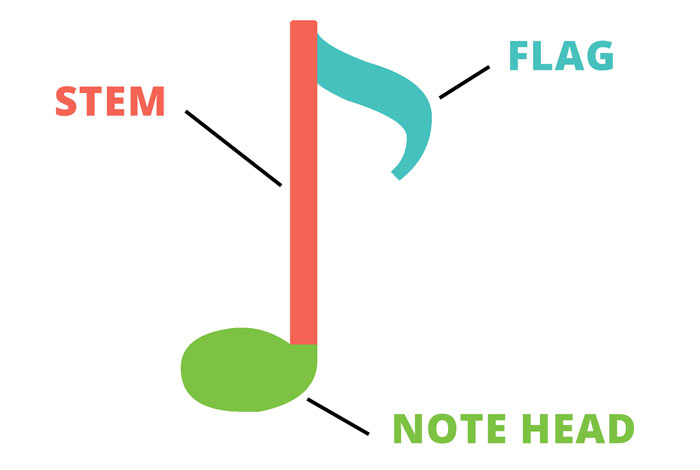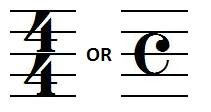This basic music theory guide will take you across fundamental concepts musicians use to understand, analyze, communicate, perform, and create music. Its study will allow you to enrich your creativity and develop a keen sense of musical awareness.
Music theory is a discipline used to understand the language of music, its concepts and rules, through its organisation and notation. It puts the ideas and practices of music into a written form, where they can be studied and passed on to others. It's a way to describe and explain music and how it's constructed.
THE FOUNDATIONAL ELEMENTS TO MUSIC NOTATION AND HOW THEY INTERACT TOGETHER
This lesson will break down and bring detailed information on the different subjects evoked in this video, giving an overview of fundamental aspects of music theory for beginners.
A pitch is a sound determined by the speed of its vibration (frequency). It corresponds to a very specific note in the staff.
Because music employs a set of pitches (ranging from low to high), the staff acts like a map allowing us to read or write their corresponding notes as lower or higher:

For example, the note C could be any C within the range of an instrument or a voice: high, low, or in the middle.
Before going through the principal elements of rhythm and melody, we will see how a staff, or two staves, could accommodate all the possible notes that can be played in a musical instrument:
The 2 principal clefs:
A clef is a musical symbol placed at the very beginning of the staff, indicating the name and pitch of a particular note. It is a reference point telling us that a particular line or space corresponds to a specific note on your instrument. (edited)
The treble clef is the most widely-used clef. It is also called the “G clef” because the symbol at the beginning of the staff (a stylized letter “G”) encircles the second line of the staff, indicating that line to be G: 
The added line corresponding to the lower C note is called a ledger line
As we see in the video, instead of adding many ledger lines below the staff, we use a Bass clef - also called the F clef because it indicates the line corresponding to the note “F”.

Now by combining these two staves together we obtain a “grand staff”.
This combination clef is used for a variety of instruments, including piano, organ, marimba, harp, and more.
Both staves are played by one person at the same time, so it’s important to be comfortable reading both clefs. Let’s see how a C major scale looks like in this context:

Most instruments do not have as wide a range as the instruments cited above: an instrument like the flute plays relatively higher notes and only reads from the treble (G) clef.
Likewise, a low-sounding instrument like the tuba only reads from the bass (F) clef.
Now we know how the notes are placed in the staff, let's describe the basic elements of the time aspect of music: the RHYTHM.
Rhythm is what gives motion to music. You can hear it in falling raindrops, a running horse, the dribbling of basketball, and so on. It is also the one indispensable element of all music.
Rhythm can exist without melody, as in the drumbeats of so-called primitive music, but melody cannot exist without rhythm.
The beat is the basic unit of time, the pulse listeners would tap their toes to when listening to a piece of music. It divides the time into little fragments having all the same duration.
The number of beats in a minute decides the tempo of music. 120 BPM (beats per minute) for example is considered a standard.
The beat of a song remains the same. However, unless we are playing to a metronome, the tempo is likely to change.
Note values represent the duration of notes, which are determined by the note head and stem:
- The note head is the round part of the note and it can be filled in or hollow.
- The stem is the vertical line which stems from the note head.

The different parts of a note:

As their fraction-like names imply, the relative values of the notes are:

With eighth notes (and other small values that we will discuss later), two or more stems can be conveniently beamed together. This is a visually comfortable alternative to writing multiple flags. We just replace the flag(s) with a beam(s) at the end of the stems:

Now that we know what stems are and what they do, let's look at how we must draw them. Stems extend downward and are on the left side of the note head when the note is on or above the third line of any staff.

Stems extend upward and are on the right side of the note head when the note is below the third line of any staff.

Music, and the music staff is usually divided into equal parts by vertical lines. The space created by two bar lines is called either a Measure or a Bar.
Bar lines go all the way through the staff. On the grand staff, the bar lines go through the entire staff.

A time signature is the part of the music that tells us the rhythmic feel of a song.
It tells us how many beats (pulses) are contained in each measure (bar), and which note value is equivalent to a beat.
Like a clef, a time signature goes at the left side of the staff, but to the right of the clef. It consists of two numbers arranged vertically.

The upper number indicates how many beats are in each measure
The lower number indicates which note value counts for one beat.

In 4/4 time, the quarter note counts for one beat and there are four beats per measure.

Common time is another way of notating and referring to the 4/4 time signature, and as we will see in the example at the end of this lesson, this time signature may be written in its fraction form of 4/4 or with a C-shaped semicircle.
For any time signature in which the upper figure is a multiple of 3, such as 3/4 and 6/8, beats are divided into three notes.

In 3/4 time, the quarter note counts for one beat and there are three beats per measure.
Another example in 4/4 time, with different note values described previously:

Again, four quarter notes equal two half notes, one whole note, and eight eighth notes.
Rests:
Spaces of silence in music are as important as pauses in speech and periods after sentences. One of the most basic and ancient instruments, the voice, needs silences and rests to allow the fundamental act of breathing.
Exactly like note values, there are rest values. Rests count the beats of silence.
Each type of rest shares a duration with a certain type of note:

Note the placement of each rest as it relates to the third space of the staff:

Let’s take an example with a measure of 4/4 time with quarter notes:

Now we replace the second quarter note by a quarter rest:

The second beat is now silent.
The whole rest represents a full measure of rest in any time signature, so the number of beats it represents changes according to the time signature:

In 4/4 time a rest equals four beats
In 3/4 time a rest equals three beats
In 2/4 time a rest equals two beats
Here is another example, in a 3/4 time, where the third beat is silent:

Dots and ties
A dot, placed to the immediate right of the notehead or a rest, is used to increase its time-value by half. For example, a dot placed after a half note will be equal to the half note plus a quarter note. A dot placed after a quarter note will be equal to a quarter note plus an eighth note.

There is a rule for dot placement for notes in a single melody - the dot is written to the right of the notehead, in the space beside a space note and in the space above the line for a line note:

A tie is usually used for holding a single note for a longer period of time. It connects two notes, making their duration as long as the combination of the two notes.

In this example the fourth quarter note tied to the next one, changing its duration to two beats.

In this case the tie creates a six beat duration: four in the first measure plus two in the second measure
Without rhythm, notes would just be long, sustained sounds.
Without pitch, each sound would be the same.
So, by combining pitches and rhythms, we can start constructing melodies.
Pachelbel Canon in D:
Let’s recap the musical elements described in this lesson by seeing how they interact together in this example, a classical piece written by Johann Pachelbel called Canon in D.
First melody:

The C shaped symbol indicates the time signature is common time (4/4), telling us that the beat unit is the quarter note and there are four beats per measure.
On a slow tempo, the first two measures are played simultaneously by a cello and a harpsichord.
Because the pitches of these notes are low, we use a bass clef (F).
Second melody:
The second melody is played by a violin, and has the same rhythm as the first melody.
The first two measures of its staff contain a whole rest during two measures as the melody starts at the third mesure (bar).
Because the range of the violin is high, we use a treble clef (G).
Both melodies together in a grand staff:

The symbols (#) at the beginning of the staff indicates the key signature.
This new element will be explained in music theory lesson 2.
This music lesson was created by Mathieu Aupitre, PFCF music advisor and PFC band member